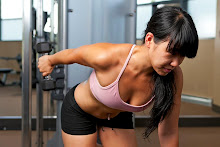Today we are going to take a look at the shoulder joint. It engages the muscles of the chest, shoulders, and back. It seems to me that everyone is more concerned about having a stronger, toned chest, but strong shoulders and back are important too. They mean better posture, a better core, and more flexibility.
The shoulder joint is referred to as the "ball-and-socket joint", which is the most mobile joint in the human body. It can abduct, adduct, rotate, and raise in many places. It has an incredible range of motion, but because of this, it tends to be one of the most injured joints.
The shoulder joint muscles moves and works a variety of different major muscle groups: the chest, shoulders, and back. More specifically, there are the deltoids (anterior, lateral, and posterior), which provide flexibility and range of motion, and enables you to move your arms forward, back, up, and down; the trapezius muscles, which form the triangle of your shoulder and upper back; the rhomboids, which pull your shoulder blades inward; the rotator cuff (supraspinatus, infraspinatus, teres minor, and subscapularis), which enables you to move your shoulder without any pain; the pectorals, your chest muscles, which flex and adduct your upper arm; and finally, the latissimus dorsi, which are large muscles on the outside (lateral side) of your trunk, and which extend, adduct, and internally rotate the shoulder joint.
Some examples of shoulder joint movement exercises that will work the muscle groups mentioned above are: shoulder presses, push-ups, pull-ups, dumbbell presses, shoulder flys, lat pull-downs, bent-over rows, and lateral arm raises.
Because of its incredible range of motion, the shoulder is often the source of pain at some point in one's life. For the most part, however, this pain can be prevented through proper maintenance of the rotator cuff muscles, which internally and externally rotate the arm (through shoulder flys and internal/external rotation).
Until next time Team, don't neglect those little muscles and chances are you'll live with pain-free shoulders for many years to come.
Health respect & happiness,
Beki


No comments:
Post a Comment
I value your insights and thoughts on what you just read, please let me know what you think!